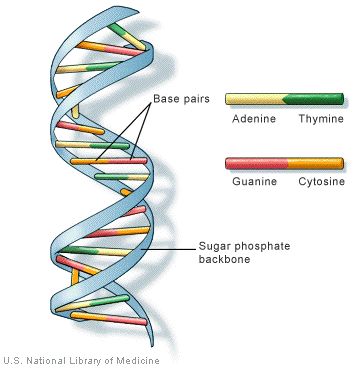[22102013] Atoms to Traits ≡
Posted on Tuesday, October 29, 2013 at 10:56 PM
1. Explain the significance of Mendel.Mendel conducted breeding experiments with peas. He discovered that different pea plants in the Austrian monk's garden showed obvious morphological differences such as tall versus short stems, wrinkled versus smooth seeds and so forth. When true-breeding pea plants of contrasting types were crossed, the offspring usually resembled one of the two parents. Without further crosses, both forms of trait could reappear in undiluted form in future generations, however, demonstrating that the genetic information for alternative forms had not blended away. Mendel's experiments changed the general perception of heritable variants from ephemeral and blendable to discreet entities passed from parents to offspring, present even though they are not always visible. Mendel's "genetic factors" were found to be mirrored by the behaviour of chromosomes in the cell nucleus.
2. Draw the structure of DNA and who discovered this structure.
They were hardly modest, these two brash young scientists who in 1953 declared to patrons of the Eagle Pub in Cambridge, England, that they had "found the secret of life." But James Watson and Francis Crick's claim was a valid one, for they had in fact discovered the structure of DNA, the chemical that encodes instructions for building and replicating almost all living things. The stunning find made possible the era of "new biology" that led to the biotechnology industry and, most recently, the deciphering of the human genetic blueprint.
DNA replication is not perfect, and errors occur. If an error is not repaired, it becomes a mutation. A mutation is any sequence of nucleotides in a DNA molecule that does not exactly match the original DNA molecule from which it was copied. A point mutation is a single nucleotide error and includes the following.
- A substitution occurs when the DNA sequence contains an incorrect nucleotide in place of the correct nucleotide.
- A deletion occurs when a nucleotide is omitted from the nucleotide sequence.
- An insertion occurs when a nucleotide is added to the nucleotide sequence.
- A frameshift mutation occurs as a result of a nucleotide deletion or insertion. Such mutations cause all subsequent nucleotides to be displaced one position. If a frameshift mutation occurs in a DNA segment whose transcription produces an mRNA, all codons following the transcribed mutation will change.
Ones mentioned in Atoms to Traits:
- Point Mutation: A single base pair change makes larger differences (i.e: between a slender dog and a muscular dog)
- Insertion: 800 base-pairs inserted to the gene of a pea produces peas that are wrinkled instead of smooth, since it disables the gene necessary for starch synthesis
- Gene Copy Number: Entire genes which are duplicated by copying errors during cell division (leads to variations amongst members of the same species)
- Duplication: Sequences containing the same base pair repeated eight or more times, known as homopolymers, are highly prone to copying errors. (i.e: In pigs, the gain of two additional C-G pairs in such a sequence inactivates a gene for a signal receptor in pigment cells, producing light-coloured coats. Copying mistakes within individual cells can also cause the duplicated sequence to lose bases, restoring the gene's function and producing dark patches on the body).
- Regulatory Changes: Mutations in the DNA that controls when and where genes are activated can produce profound trait changes by altering the formation of entire body parts during the organism's development. Changes in the regulatory regions of a single gene that controls patterns of cell division during stem development account for much of the shape difference between the bushy teosinte plant and its descendant, the tall modern cornstalk.
4. What is evo-devo?
Evolutionary developmental biology, or "evo-devo," is a broad term that encompasses a lot of things. Different people use the term slightly differently, and also what makes it interesting for them differs from scientist to scientist.
lactose intolerance. It is a revolution in developmental biology and in the biological sciences as a whole. It has gotten to the point where we can start to understand how genes make up and embryo form the way it does, why a limb forms in the first place and why the arm is different from the leg, why the heart that starts as a tube in the middle folds up to be on the left and not the right and so on. We are also getting tot he point where we can understand now only how we can make a limb, but how the process can be altered in what are actually subtle ways such that the limb takes the form of a bat wing versus a human hand versus a flipper.
5. Make a connection between human migration and the mutation of lactose intolerance.
Humans were first traced back to Africa then to the Middle East, which is why different mutations affecting the same gene (of producing lactase as adults) were found to predominate in East Africa and Saudi Arabian populations. The longer a gene has been there, the more space there is to make "errors" in the coding, or in other words, the more time there is for multiple mutations to occur.


0 Comment:
Post a comment